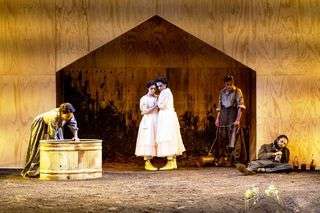|
Back
Prairie Song New York
Miller Theater, Columbia University
09/26/2018 - & September 28, 2018
Missy Mazzoli: Proving Up (New York Premiere)
Michael Slattery (Miles Zegner), John Moore (Mr. Johannes “Pa” Zegner), Talise Trevigne (Mrs. Johannes “Ma” Zegner), Cree Carrico (Zegner Daugther, Littler), Abigail Nims (Zegner Daughter, Taller), Andrew Harris (The Sodbuster), Sam Shapiro (Peter Zegner)
Musicians of International Contemporary Ensemble, Christopher Rountree (Conductor)
James Darrah (Production), Nathan Troup (Stage Designer), Adam Rigg (Scenic Designer), Chrisi Karvonides-Dushenko (Costume Designer), Pablo Santiago (Lighting Designer), Ronell Oliveri (Wig and Makeup Designer)

R. Vavrek, M. Mazzoli
(© Bob Davidson for Miller Theater)
Missy Mazzoli, before the age of 40, has proven herself one of America’s finest composers. Yet her operatic inspiration is of no school: she fits her music to her subject so fittingly that one hears her opera, and hears the passion behind it.
In Proving Up, she has taken the same atmosphere as Copland’s The Tender Land, but she has transformed it into a tragedy which is so searing, so (yes) mysterious, as passionate as it is (towards the end) enigmatic, that the New York premiere last night may well be a listed a masterpiece. Added to this is librettist Royce Vavrek, the 2018 equivalent of Auden, De Ponte and Boito, a man who obviously understands that dialogue in an opera–like music–must augment emotions which aren’t sufficient on their own.

T. Trevigne, C. Carrico, A. Nims, M. Slattery, J. Moore
(© Bob Davidson for Miller Theater)
The emotions in this one-set story, set on the 1868 prairies of Nebraska, where the farmers have been enticed by the Nebraska 1862 Homestead Act which may allow them to follow the American Dream (not yet a cliché in this country). We have here one family, yet a family of mythic proportions. Father (John Moore) has suffered the death of two daughters, the paralyzing infirmities of a son (Sam Shapiro), another son (Michael Slattery) who knows too much about his father, and a mother (Talise Trevigne) who prays to her god...for rain, and for some kind of tranquility in this star-cursed family.
The two dead daughters, Abigail Nims and Cree Carrico, are operatically alive. They dance, they prance, they play harmonica, even see their own bodies on the stage. That scene, where the haunting soprano of Ms. Trevigne picks flowers on their graves, while the two girls gaze on the action, is the only scene where Ms. Mazzoli uses the full force of her orchestra, a short brass choir accompanying their agony.
The one linking force of Proving Up is a window. Yes, a window. The bureaucrats in Washington had decreed that Land Ownership Title to five years of habitation on the land–and–and a glass window to the house. (I Googled this Act, but found no reference to a window. Perhaps it was implied.) Father Moore has a window, and, with rumors that an “Inspector” would come, he says that “farmers must help farmer”, he send his one healthy son to deliver the window to a neighbor, and come back before the Inspector.
These four parts of the seven-part opera do not exactly tingle with excitement on paper. On the Miller Theater stage, though, the Mizzoli/Vavrek combination, with the ICE Orchestra led by Christopher Rountree, give us an agonizing picture. The musical picture starts with a folkish melody, sung with the rich sounds of Mr. Moore. Yet by the fifth measure, when his family appears, when we see him dangling the whiskey bottle, twisting around the stage, that original song become a portent of Fate.
The story–a simple delivery of a window on the Nebraska prairie–becomes an opera of mystery, of ferocity, of hidden motive, of the violence in acquiring this precious window in an atmosphere where not even a shard is available. Add to this Mr. Slattery, the healthy son whose tenor voice confesses thoughts to his pet pig (played with conviction by a tin kettle), and who forces, along with the ghostly sisters, to make his father confess to a previous crime.
Not Ms. Mazzoli, but librettist Vavrek, possibly with the original short-story author, Karen Russell, has a genius in repeating lines...about the window, about the rain, about this Inspector. Somehow he transforms the Inspector into “a rumor”, a “smoke” into a puzzling Godot to, at the end, God Itself. Never are these repetitions clever effects. Mr. Vavrek has achieved his fame by subtly bringing us from the “natural” world into a world of myth. The window is obviously a symbol, yet we believe in this window, we believe that Mr. Moore has an altruistic motive in loaning that window to a neighbor.
Once Mr. Slattery takes off on his journey over the prairie on a mock horse, he is alone save for the two dead sisters, save for the window. And is thrown off during a sandstorm.
Up to this point, Proving Up was a taut relentless drama of Greek dimensions One could have imagined Aeschylus or Eugene O’Neill turning the Zegner family into a prairie House of Atreus. Or Annie Proulx changing her Wyoming into a Nebraska tragedy. With the appearance of Andrew Harris as the Sodbuster, Royce Vavrek transforms this into a Biblical allegory.

A. Harris
(© Bob Davidson for Miller Theater)
Mr. Harris, a basso profundo–with a few scary falsetto measures–comes out of the wilderness resembling what one imagines the Prophet Jeremiah to look like. The huge cloak, the frightening eyes, the clump-clump of steps, the monstrous muscles bulging from his tall stooped body.
Instead of Jeremiads, though, “the Sodbuster” sings a combination of mystery poetics, a dreadful oracle, a lumbering failure of the American dream–and a killer as well.
It is stark, both musically (Ms. Mazzoli is sparing with her chamber orchestra), and verbally, though not emotionally. Not with the young Mr. Slattery ready for sacrifice, not with the ghostly sisters crying and laughing and dancing.
The scene is so gripping that one’s willing disbelief never wonders at the strangeness of it all. It is mapped out so well that one forgets this is Mr. Vavrek’s Diabolus ex machina.
Unhappily, it leads to a final scene which is the only scene in this relentlessly great opera which is disappointing. In an opera where the nuance of violence is in every note, every word, we have real violence. In an opera where the links of family–living and dead–are taut with vibrations, we have an alien personage, a puzzling ending which leaves us querying rather than quivering.
Perhaps Karen Russell’s short story gives a clue to this ending, but that wasn’t apparent here. Up to this moment, Proving Up is an undoubted dramatic masterpiece. The fact that Royce Vavrek creates each repetition of phrases so mesmeric, and that Ms. Mazzoli creates both a musical background and ghostly intimations of folk music, and that director James Darrah directs the hour-plus scena with virtually such a sure hand, is a gift. More than a gift. Outside of perhaps my own shortcoming at the end, Proving Up becomes the blessing offered from the Antichrist of the American Dream.
Harry Rolnick
|